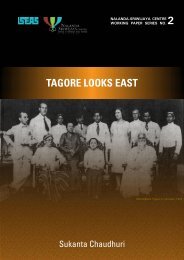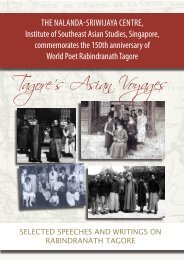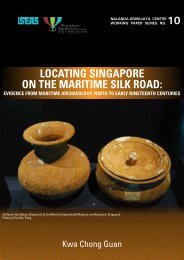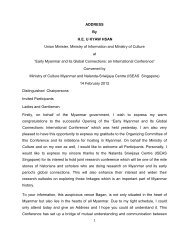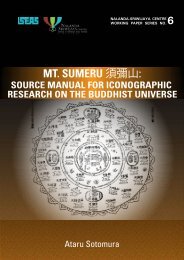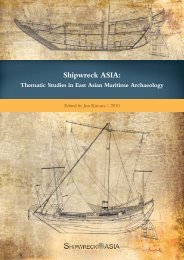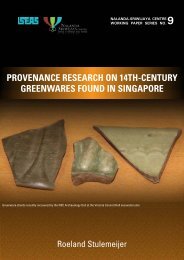Boni in Chinese Sources - Nalanda-Sriwijaya Centre - iseas
Boni in Chinese Sources - Nalanda-Sriwijaya Centre - iseas
Boni in Chinese Sources - Nalanda-Sriwijaya Centre - iseas
You also want an ePaper? Increase the reach of your titles
YUMPU automatically turns print PDFs into web optimized ePapers that Google loves.
Kurz: <strong>Boni</strong> <strong>in</strong> Ch<strong>in</strong>ese <strong>Sources</strong> NSC Work<strong>in</strong>g Paper No. 4Their Buddha is not different [from ours]. It is housed <strong>in</strong> a reed‐covered build<strong>in</strong>g ofseveral storeys that is built like a pagoda. Below it is a small shr<strong>in</strong>e that shelters twopearls, which are called the Sage (sheng 聖 ) and the Buddha (fo 佛 ). 30The local people say: “The two pearls were <strong>in</strong> the beg<strong>in</strong>n<strong>in</strong>g quite small, but theyhave gradually grown to the size of thumbs.” On the festival of the Buddha, the k<strong>in</strong>gpersonally makes offer<strong>in</strong>gs of flowers and fruit for three days, and all the men andwomen of the country attend.In the second year of the Taip<strong>in</strong>g x<strong>in</strong>gguo era (977), he sent Puyali and others tosubmit camphor, tortoise‐shell, ivory and sandal‐wood as tribute. The memorial [tothe throne] was sealed several times; its paper was made from wooden bark and itwas th<strong>in</strong>. It was bright and smooth and of a subtle green colour. It was several chilong, more than a cun wide, and when rolled up it could be held <strong>in</strong> one hand.The characters on it were t<strong>in</strong>y and small and had to be read horizontally. Theirtranslation <strong>in</strong>to Ch<strong>in</strong>ese reads: “I, Xiangda, k<strong>in</strong>g of <strong>Boni</strong>, kowtow before You, and Iwish the emperor ten thousand times ten thousand times 100 million years.” Itfurthermore said: “As I am prepar<strong>in</strong>g [to submit] tribute every year, the w<strong>in</strong>ds mayblow our ship to the territory of Zhancheng. I beg the emperor to order Zhanchengnot to reta<strong>in</strong> [Xiangda’s ship] from now on.” The envoys were lodged <strong>in</strong> the ForeignRelations Office (lib<strong>in</strong> yuan 禮 賓 院 ) 31 , and they were given lavish presents on theirreturn<strong>in</strong>g home.In the fifth year of the Yuanfeng era (1082) they sent a further tribute mission.Xilonggong 西 龍 宮 , Shimiao 什 廟 , Rili 日 麗 , Hulumantou 胡 蘆 蔓 頭 , Suwuli 蘇 勿 里 ,Madanyumanuo 馬 膽 逾 馬 喏 are located on islands 32 and they communicate withsmall boats. Their dress and food and dr<strong>in</strong>k are the same as that of <strong>Boni</strong>. Theyproduce <strong>in</strong>cense, jiangzhen‐<strong>in</strong>cense, bee’s wax, and tortoise‐shell. Traders exchangewith them white porcela<strong>in</strong>, alcohol, rice, crude salt, white th<strong>in</strong> silk, and trade goldfor these products. 3330 As there is not much more <strong>in</strong>formation about the two pearls, I use the present translation. To give one nameto two th<strong>in</strong>gs, as Hirth and Rockhill did by address<strong>in</strong>g the pearls as the Sacred Buddha, appears to be ratherillogical.31 Accord<strong>in</strong>g to Hucker, who relies solely on the monographs on <strong>in</strong>stitutions <strong>in</strong> the Songshi, the lib<strong>in</strong> yuan dealtwith Uighurs and other people from Central Asia. See Hucker, Official Titles, 306. The Song huiyao states,however, that apart from Central Asian people, those from the southern regions were also received there, andthat the officials <strong>in</strong> this agency could communicate <strong>in</strong> their languages. See Song huiyao jigao 宋 會 要 輯 稿 ,comp. by Xu Song 徐 松 (1781‐1848) (Beij<strong>in</strong>g: Zhonghua shuju, 1997), “zhiguan” 職 官 25, 6b‐7b (2917).32 Cf. the translation of this passage <strong>in</strong> Chao Ju‐kua, 157‐158, where the places concerned are identified as “Silung,Kung‐shï‐miau, Jï‐li‐hu, Lu‐man, T'ou‐ssu, Wu‐li‐ma, Tan‐yü, Ma‐jö”. I follow <strong>in</strong> my translation the namesgiven <strong>in</strong> the modern Ch<strong>in</strong>ese edition of the text.33 Zhufanzhi jiaoshi, 135‐137.10





